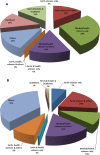Seeking evidence of multidisciplinarity in environmental geochemistry and health: an analysis of arsenic in drinking water research
- PMID: 28236208
- PMCID: PMC5797562
- DOI: 10.1007/s10653-017-9919-4
Seeking evidence of multidisciplinarity in environmental geochemistry and health: an analysis of arsenic in drinking water research
Abstract
A multidisciplinary approach to research affords the opportunity of objectivity, creation of new knowledge and potentially a more generally acceptable solution to problems that informed the research in the first place. It increasingly features in national programmes supporting basic and applied research, but for over 40 years, has been the arena for many research teams in environmental geochemistry and health. This study explores the nature of multidisciplinary research in the earth and health sciences using a sample selected from co-authored articles reporting research on arsenic (As) in drinking water from 1979 to 2013. A total of 889 relevant articles were sourced using the online version of the science citation index-expanded (SCI-expanded). The articles were classified according to author affiliation and later by author discipline/research interests using the Revised Field of Science and Technology Frascati manual DSTI/EAS/STP/NESTI (2006) 19/FINAL and a decision algorithm. Few articles were published on the topic until 2000. More articles were published across all affiliations in the last 10 years of the review period (2004-2013) than in the first 10 years (1979-1988). Only 84 (~9%) articles fell within the "earth and health" only and "earth, health and other" categories when classification was undertaken by author affiliation alone. This suggests that level of collaboration between earth and health scientists in arsenic in drinking water research may be very low. By refining the classification further using author discipline/research interests, only 28 of the 84 articles appear to be co-authored by earth and health scientists alongside professionals in other fields. More than half of these 28 articles involved descriptive non-experimental, observational study designs, limited in direct causal hypotheses and mechanistic investigation. If collaborative research is to lead to the increased multidisciplinary research, early interaction should be encouraged between students from different disciplines. In order to achieve multidisciplinarity in practise, it is imperative that scientific communities and research agencies do more to encourage interaction and integration between researchers from different disciplines. This must develop from educational institutions seeing opportunities to improve graduate skills in an increasingly diverse research landscape.
Keywords: Arsenic; Health; Multidisciplinary; Research design; Water.
Conflict of interest statement
At the time of the work reported here, Abiodun Aderibigbe was an MSc student supervised by Andrew Hursthouse and Alex Stewart, who were executive members of SEGH.
Figures







Similar articles
-
Arsenic contamination of drinking water in Ireland: A spatial analysis of occurrence and potential risk.Sci Total Environ. 2017 Feb 1;579:1863-1875. doi: 10.1016/j.scitotenv.2016.11.171. Epub 2016 Dec 6. Sci Total Environ. 2017. PMID: 27932216
-
Highly cited articles in health care sciences and services field in Science Citation Index Expanded. A bibliometric analysis for 1958 - 2012.Methods Inf Med. 2014;53(6):446-58. doi: 10.3414/ME14-01-0022. Epub 2014 Oct 10. Methods Inf Med. 2014. PMID: 25301516 Review.
-
Geostatistical modelling of arsenic in drinking water wells and related toenail arsenic concentrations across Nova Scotia, Canada.Sci Total Environ. 2015 Feb 1;505:1248-58. doi: 10.1016/j.scitotenv.2014.02.055. Epub 2014 Mar 7. Sci Total Environ. 2015. PMID: 24613511
-
Mapping of drinking water research: a bibliometric analysis of research output during 1992-2011.Sci Total Environ. 2013 Jan 15;443:757-65. doi: 10.1016/j.scitotenv.2012.11.061. Epub 2012 Dec 8. Sci Total Environ. 2013. PMID: 23228721
-
Association of inorganic arsenic exposure with type 2 diabetes mellitus: a meta-analysis.J Epidemiol Community Health. 2014 Feb;68(2):176-84. doi: 10.1136/jech-2013-203114. Epub 2013 Oct 16. J Epidemiol Community Health. 2014. PMID: 24133074 Review.
Cited by
-
Techno-economic feasibility and life cycle assessment analysis for a developed novel biosorbent-based arsenic bio-filter system.Environ Geochem Health. 2024 Feb 17;46(3):79. doi: 10.1007/s10653-023-01839-7. Environ Geochem Health. 2024. PMID: 38367087
-
Machine Learning Models of Arsenic in Private Wells Throughout the Conterminous United States As a Tool for Exposure Assessment in Human Health Studies.Environ Sci Technol. 2021 Apr 20;55(8):5012-5023. doi: 10.1021/acs.est.0c05239. Epub 2021 Mar 17. Environ Sci Technol. 2021. PMID: 33729798 Free PMC article.
-
A Bibliometric Analysis of Research on Supported Ionic Liquid Membranes during the 1995-2015 Period: Study of the Main Applications and Trending Topics.Membranes (Basel). 2017 Nov 7;7(4):63. doi: 10.3390/membranes7040063. Membranes (Basel). 2017. PMID: 29112172 Free PMC article.
References
-
- Abejon R, Garea A. A bibliometric analysis of research on arsenic in drinking water during the 1992–2012 period: An outlook to treatment alternatives for arsenic removal. Journal of Water Process Engineering. 2015;6:105–119. doi: 10.1016/j.jwpe.2015.03.009. - DOI
-
- Ahsan H, Chen Y, Parvez F, Argos M, Hussain AI, Momotaj H, Levy D, Van Geen A, Howe G, Graziano J. Health effects of arsenic longitudinal study (HEALS): Description of a multidisciplinary epidemiological investigation. Journal of Exposure Science and Environmental Epidemiology. 2006;16:191–205. doi: 10.1038/sj.jea.7500449. - DOI - PubMed
-
- Asante KA, Agusa T, Biney CA, Agyekum WA, Bello M, Otsuka M, Itai T, Takahashi S, Tanabe S. Multi-trace element levels and arsenic speciation in urine of e-waste recycling workers from Agbobloshie, Accra in Ghana. Science of the Environment. 2012;424:63–73. - PubMed
MeSH terms
Substances
LinkOut - more resources
Full Text Sources
Other Literature Sources
Medical
Research Materials

